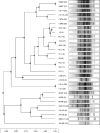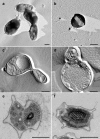Determination of the diversity of Rhodopirellula isolates from European seas by multilocus sequence analysis
- PMID: 19948850
- PMCID: PMC2813027
- DOI: 10.1128/AEM.01525-09
Determination of the diversity of Rhodopirellula isolates from European seas by multilocus sequence analysis
Abstract
In the biogeography of microorganisms, the habitat size of an attached-living bacterium has never been investigated. We approached this theme with a multilocus sequence analysis (MLSA) study of new strains of Rhodopirellula sp., an attached-living planctomycete. The development of an MLSA for Rhodopirellula baltica enabled the characterization of the genetic diversity at the species level, beyond the resolution of the 16S rRNA gene. The alleles of the nine housekeeping genes acsA, guaA, trpE, purH, glpF, fumC, icd, glyA, and mdh indicated the presence of 13 genetically defined operational taxonomic units (OTUs) in our culture collection. The MLSA-based OTUs coincided with the taxonomic units defined by DNA-DNA hybridization experiments. BOX-PCR supported the MLSA-based differentiation of two closely related OTUs. This study established a taxon-area relationship of cultivable Rhodopirellula species. In European seas, three closely related species covered the Baltic Sea and the eastern North Sea, the North Atlantic region, and the southern North Sea to the Mediterranean. The last had regional genotypes, as revealed by BOX-PCR. This suggests a limited habitat size of attached-living Rhodopirellula species.
Figures




Similar articles
-
An improved isolation method for attached-living Planctomycetes of the genus Rhodopirellula.J Microbiol Methods. 2009 Jun;77(3):276-84. doi: 10.1016/j.mimet.2009.03.002. Epub 2009 Mar 18. J Microbiol Methods. 2009. PMID: 19303037
-
Diversity of Rhodopirellula and related planctomycetes in a North Sea coastal sediment employing carB as molecular marker.FEMS Microbiol Lett. 2015 Sep;362(17):fnv127. doi: 10.1093/femsle/fnv127. Epub 2015 Aug 6. FEMS Microbiol Lett. 2015. PMID: 26253575
-
Multilocus sequence analysis for the assessment of phylogenetic diversity and biogeography in hyphomonas bacteria from diverse marine environments.PLoS One. 2014 Jul 14;9(7):e101394. doi: 10.1371/journal.pone.0101394. eCollection 2014. PLoS One. 2014. PMID: 25019154 Free PMC article.
-
Microdiversity of deep-sea Bacillales isolated from Tyrrhenian sea sediments as revealed by ARISA, 16S rRNA gene sequencing and BOX-PCR fingerprinting.Microbes Environ. 2013;28(3):361-9. doi: 10.1264/jsme2.me13013. Epub 2013 Sep 5. Microbes Environ. 2013. PMID: 24005887 Free PMC article.
-
High diversity of Vibrio spp. associated with different ecological niches in a marine aquaria system and description of Vibrio aquimaris sp. nov.Syst Appl Microbiol. 2020 Sep;43(5):126123. doi: 10.1016/j.syapm.2020.126123. Epub 2020 Jul 18. Syst Appl Microbiol. 2020. PMID: 32847789
Cited by
-
Planctomycetes as Host-Associated Bacteria: A Perspective That Holds Promise for Their Future Isolations, by Mimicking Their Native Environmental Niches in Clinical Microbiology Laboratories.Front Cell Infect Microbiol. 2020 Nov 30;10:519301. doi: 10.3389/fcimb.2020.519301. eCollection 2020. Front Cell Infect Microbiol. 2020. PMID: 33330115 Free PMC article.
-
Multilocus sequence analysis for assessment of phylogenetic diversity and biogeography in Thalassospira bacteria from diverse marine environments.PLoS One. 2014 Sep 8;9(9):e106353. doi: 10.1371/journal.pone.0106353. eCollection 2014. PLoS One. 2014. PMID: 25198177 Free PMC article.
-
Bioinformatic analyses of integral membrane transport proteins encoded within the genome of the planctomycetes species, Rhodopirellula baltica.Biochim Biophys Acta. 2014 Jan;1838(1 Pt B):193-215. doi: 10.1016/j.bbamem.2013.08.007. Epub 2013 Aug 19. Biochim Biophys Acta. 2014. PMID: 23969110 Free PMC article.
-
Bringing Planctomycetes into pure culture.Front Microbiol. 2012 Dec 3;3:405. doi: 10.3389/fmicb.2012.00405. eCollection 2012. Front Microbiol. 2012. PMID: 23335915 Free PMC article.
-
A Novel κ-Carrageenase from Marine Bacterium Rhodopirellula sallentina SM41: Heterologous Expression, Biochemical Characterization and Salt-Tolerance Mechanism Investigation.Mar Drugs. 2022 Dec 16;20(12):783. doi: 10.3390/md20120783. Mar Drugs. 2022. PMID: 36547930 Free PMC article.
References
-
- Achtman, M. 2008. Evolution, population structure, and phylogeography of genetically monomorphic bacterial pathogens. Annu. Rev. Microbiol. 62:53-70. - PubMed
-
- Cladera, A. M., L. D. C. Sepulveda-Torres, M. Valens-Vadell, J. M. Meyer, J. Lalucat, and E. Garcia-Valdes. 2006. A detailed phenotypic and genotypic description of Pseudomonas strain OX1. Syst. Appl. Microbiol. 29:422-430. - PubMed
-
- Gade, D., H. Schlesner, F. O. Glockner, R. Amann, S. Pfeiffer, and A. Thomm. 2004. Identification of Planctomycetes with order-, genus-, and strain-specific 16S rRNA-targeted probes. Microb. Ecol. 47:243-251. - PubMed
-
- Glöckner, F. O., M. Kube, M. Bauer, H. Teeling, T. Lombardot, W. Ludwig, D. Gade, A. Beck, K. Borzym, K. Heitmann, R. Rabus, H. Schlesner, R. Amann, and R. Reinhardt. 2003. Complete genome sequence of the marine planctomycete Pirellula sp. strain 1. Proc. Natl. Acad. Sci. U. S. A. 100:8298-8303. - PMC - PubMed
Publication types
MeSH terms
Substances
Associated data
- Actions
- Actions
LinkOut - more resources
Full Text Sources
Miscellaneous

